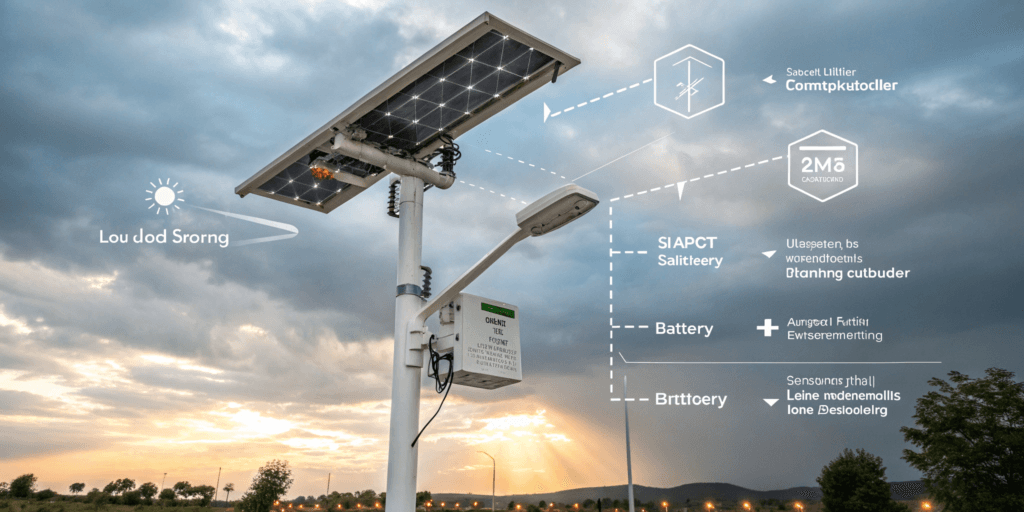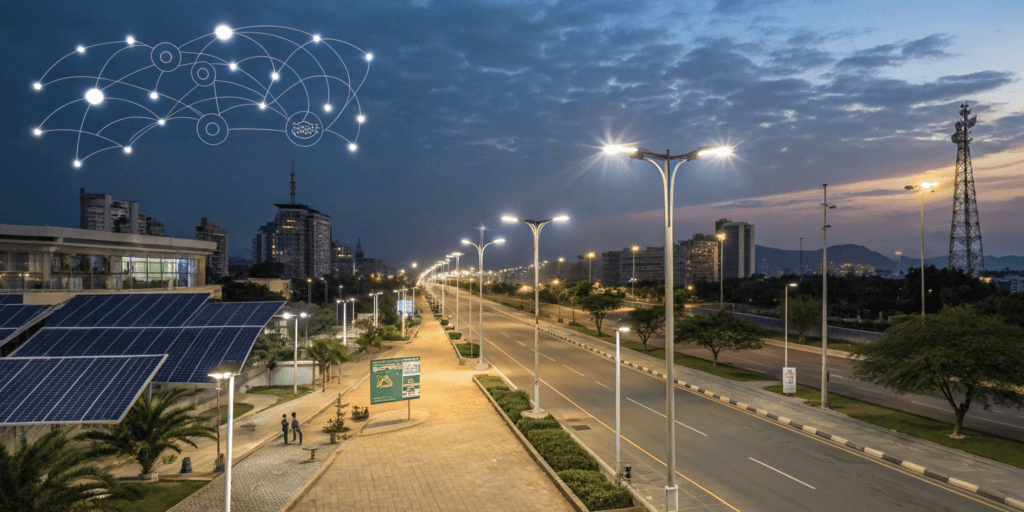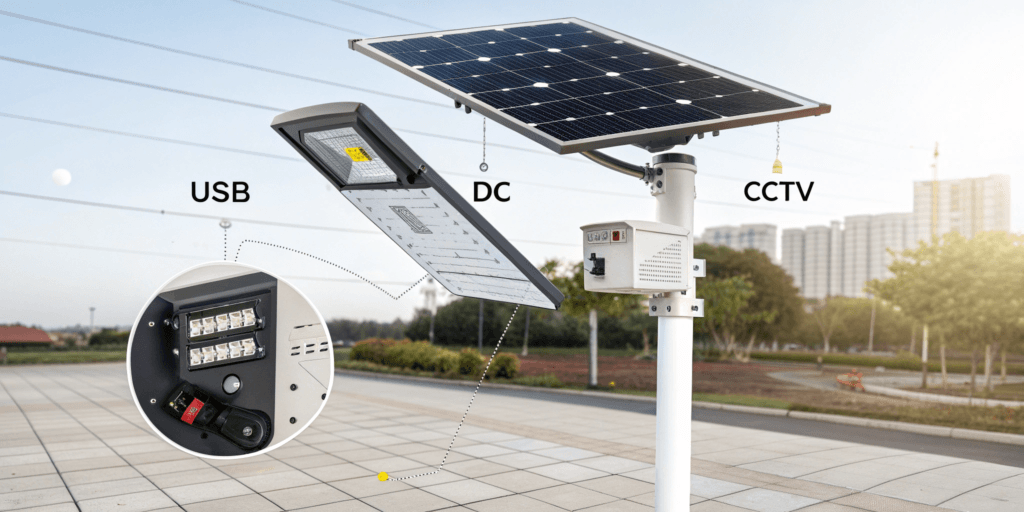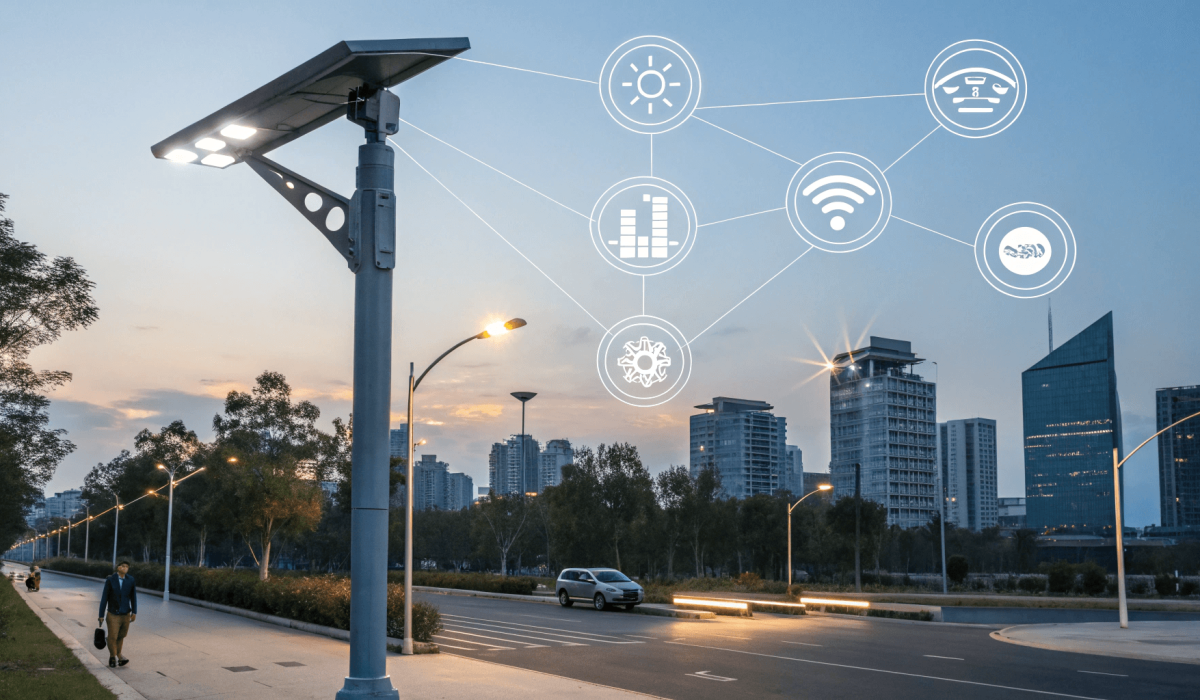Not every solar street light labeled “smart” is truly smart.
A truly smart solar street light integrates advanced sensors, control systems, and remote communication technologies to save energy, extend system life, and lower maintenance.
As smart cities expand, more buyers seek intelligent solar lighting systems. But “smart” isn't just a buzzword — it's about real technology that delivers results. Here are the five core features that define a smart solar street light.
Intelligent Motion Sensors?
In both urban and rural areas, pedestrian and vehicle traffic is sporadic, not constant.
What is PIR?
Passive Infrared (PIR) sensors detect the heat emitted by people or vehicles. When motion is detected, the light instantly brightens to 100%. When no movement is sensed, it dims to 30–40% to save energy while maintaining basic visibility.
Why it matters
- Energy saving: Brightens only when needed, reducing power consumption by over 50%.
- Battery longevity: Dimming at night reduces discharge rate, crucial during rainy seasons.
- Enhanced safety: Automatically increases brightness when activity is detected, improving visibility and deterring crime.
Real-world example
In a suburban community outside Kampala, Uganda, we deployed 120 PIR-equipped lights. Within two months, residents reported improved visibility at night and greater confidence in the reliability of the lights, especially during cloudy weeks.
Recommended specs
| Parameter | Recommended Value |
|---|---|
| Sensing Range | 5–12 meters |
| Angle | ≥120° |
| Response Time | ≤1 second |
| Brightness Shift | Auto 30%–100% |
Smart Energy Management System (EMS)?

In real use, sunlight isn’t always consistent — especially during long rainy seasons in West or East Africa.
What is EMS?
The Energy Management System is built into the controller and uses intelligent algorithms to read solar input, battery status, and LED consumption in real time, making dynamic decisions to optimize power use.
Key advantages
- Adjusts LED output during cloudy or dusty days to extend runtime.
- Analyzes power history to automatically switch to eco mode if multiple days of low charging occur.
- Protects the battery from overcharge, deep discharge, and overheating — especially vital for LiFePO4 batteries.
Deployment insight
In Northern Ghana, we installed EMS-equipped lights in mountainous regions with inconsistent sun. While traditional lights shut off after two cloudy days, our EMS-enabled systems continued operating at dimmed brightness even after five sunless days.
Recommended EMS Settings
| Feature | Preferred Setting |
|---|---|
| Solar input tracking | MPPT Controller |
| Discharge depth control | ≥80% adaptive setting |
| Multi-day weather mode | 3-day forecast logic |
| Overheat protection threshold | Auto cutoff ≥70°C |
Remote Monitoring and IoT Control?

Managing a single lamp is easy. Managing 1000+ across districts is not — unless it’s smart.
How does IoT work?
Each unit connects via GSM, LoRa, or WiFi to a cloud-based platform. Users can access a dashboard via computer or mobile to view:
- Battery status
- Lighting hours
- Fault alerts (e.g., charging issues, light not working)
- Location-based lamp status via GPS map
Why it matters
- Real-time monitoring enables faster responses.
- Adjust schedules remotely without climbing poles.
- Proactive alerts help prevent widespread failure.
Use case
In Abuja, Nigeria, we installed 150 IoT-enabled lights with centralized control. Within one year, the system flagged 14 battery degradation warnings — all replaced before failure, reducing service costs by 25%.
Connectivity comparison
| Protocol | Range | Power Use | Best For |
|---|---|---|---|
| GSM | Unlimited | Medium | Urban/Rural areas |
| LoRa | 1–5 km | Low | Large scale deployments |
| WiFi | ~100 meters | High | Campus or gated zones |
Adaptive Dimming and Scheduling?
Keeping lights at full brightness all night is unnecessary — and wasteful.
What is adaptive dimming?
Lights come with RTC clocks or can be programmed remotely. Example schedule:
- 7 PM–10 PM: 100% brightness (peak traffic)
- 10 PM–4 AM: dims to 40%
- 4 AM–6 AM: gradually returns to 70% for early risers
Combined with PIR sensors, the system can also brighten on-demand when motion is detected in low-traffic hours.
Key benefits
- Maximize energy savings by lowering brightness during inactive hours.
- Tailor lighting plans for seasonal or cultural events.
- Reduce light pollution in residential or nature-sensitive areas.
Case study
At a port zone in Freetown, Sierra Leone, we programmed three-phase dimming for night operations. Dock workers appreciated the lighting when needed and the community saw reduced nighttime glare.
Recommended features
| Feature | Required |
|---|---|
| Built-in RTC Clock | ✅ |
| Multi-time brightness levels | ✅ |
| Holiday/festival modes | Optional |
| Motion-linked dimming | ✅ with PIR |
All-in-One Design with Modular Expansion?

Wiring, trenching, and mounting multiple components costs time and money — and exposes systems to theft.
Why choose all-in-one?
Integrated design combines solar panel, battery, controller, and LED into a single sealed unit. Advanced models include expansion ports for:
- CCTV cameras
- WiFi hotspots
- Environmental sensors
Benefits of integration
- Simple plug-and-play installation
- Anti-theft — no exposed cables or separate boxes
- Easy to upgrade without replacing core system
- Durable against rain, wind, and heat
Implementation example
In a refugee camp near Lomé, Togo, we installed all-in-one lights with modular ports. Six months later, the site added surveillance cameras in 2 hours per unit — no rewiring, no reconfiguration.
Recommended hardware structure
| Component | Specification |
|---|---|
| Material | Die-cast aluminum + anodized finish |
| Battery Housing | Fully sealed IP66 |
| Pole Mount | Hot-dip galvanized, wind rated ≥120 km/h |
| Expansion Ports | USB, Type-C, or DC terminals |
Conclusion
A truly smart solar street light does more than switch on at night. It intelligently balances energy, adapts to traffic and weather, connects to your management system, and lasts for years with minimal upkeep.
When sourcing your next system, confirm it includes:
- PIR motion detection
- Smart Energy Management (EMS)
- IoT-based remote monitoring
- Adaptive dimming and scheduling
- All-in-one design with modular options
Don’t pay for “smart” unless every feature makes your project smarter — and more sustainable.


